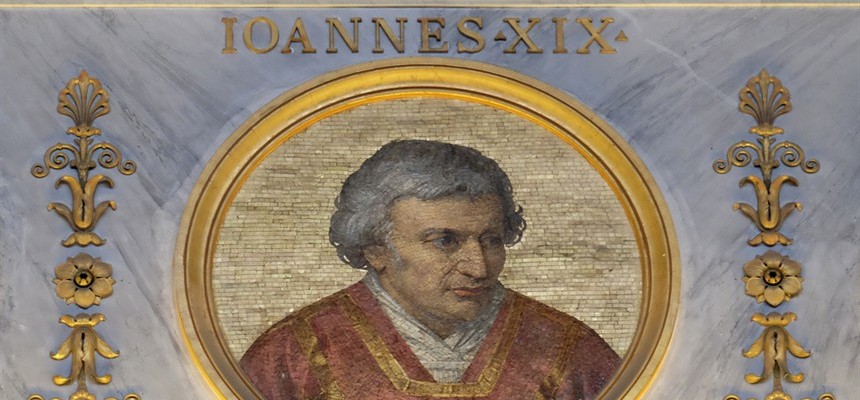
Romanus of Tusculum was the brother of Pope Benedict VIII. While his brother was on the throne of Peter, Romanus, a layman, was both counsel and senator of Rome, wielding much power. When Benedict died in April 1024, Romanus may have paid his way onto the empty throne. However, he was not a cleric, even a lesser cleric. On his election day, Romanus needed to be ordained to all seven clerical levels in order to be consecrated a bishop. He took the name John XIX at his papal consecration.
Obviously, he had no ecclesiastical knowledge or experience. In order to avoid any anti-popes or riots, and to impress the citizens of Rome, the new pope spent lavishly on celebrations and public improvements.
Soon after Pope John’s election, he received ambassadors from the Byzantine Emperor Basil II. Knowing the ex-counsel’s penchant for bribes, the ambassadors came with large amounts of gifts and a request from the Patriarch of Constantinople, Eustathius. He wanted Rome to acknowledge his title of ecumenical bishop, basically raising him to the level of the pope, but for the Eastern Church. John did not seem to have any problem with that, considering all the gifts. Negotiations began in secret. But word got out and there was an outcry. John pulled out of negotiations. But he kept the bribe money.
In 1025, John sent a crown and his blessings to the new king, Boreslaw of Poland.
John became a patron of the famous musician Guido of Arezzo. He invited Guido to Rome to discuss the new musical notation he had invented. He kept him there to teach the Benedictines and the Roman clergy.
The Holy Roman Emperor and king of Germany, Henry II died three months after Pope Benedict. The new king was Conrad, a Frank. John supported him from the beginning. In 1027, Conrad crossed the Alps, coming to Rome to be crowned emperor on Easter. Also coming to the celebrations were King Rudolph III of Burgundy and Cnut the Great of Denmark and England. Cnut, a recent convert to Christianity, wanted to both repent of his sins and improve conditions for the pilgrims along the route to Rome (they were charged tolls to walk along the roads in different areas). In this setting, he and Rudolph negotiated a cheaper way for pilgrims to travel. The end result was witnessed by dozens of archbishops, bishops, priests and nobles.
A week later, John conducted a synod at the Lateran. He declared the Patriarch of Aquelia the only patriarch of Italy, giving him primacy over all other bishops, much to the chagrin of the Patriarch of Grado, who was demoted to bishop. Two years later, John changed his mind and gave the patriarchy back to Grado. He also gave the archbishop of Bari certain allowances. This was part of a conciliatory agreement with Patriarch Eustathius. This way, the Byzantine Rite could be allowed in exchange for the establishment of the Latin Rite in Constantinople. But the Patriarch still didn’t get his title.
Like other recent popes, John took Cluny Abbey under his protection in spite of the objections of the local bishop. He tried to talk Abbot Odilo into accepting the bishopric of Lyons. Odilo declined and John was not pleased. But he died before he could carry out any plan.
Under John XIX, the feast of St. Martial of Limoges was raised to the level of Apostle. There was written evidence that Marital had traveled with some Apostles.
It appears that John began the tradition of indulgences in exchange for alms, or, as the Protestants said, paying for a way out of penances. When the Crusades began, selling indulgences became a fund-raising activity.
Pope John XIX was an inconsistent, money-hungry man who did not understand Church law. He acted in his own best interest, for the most part. His actions led to the schism between East and West just a generation later.
He died in either October or November of 1032. Some say he died naturally. The rumor that he was attacked by angry peasants has no evidence. His young nephew became the next pope.

Recent Comments